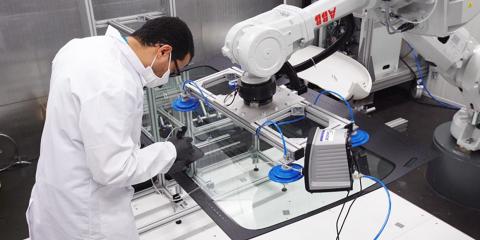Adhesive joining technology for on-demand assembly and disassembly - a story of performance, cost efficiency and circularity

Adhesive joining technology for on-demand assembly and disassembly - a story of performance, cost efficiency and circularity
Companies are in a constant search of making products lighter and stronger. That is why adhesive bonding is gaining importance in today’s manufacturing industry. By using the right bonding technique, you can significantly improve your products. However, adhesive joints require curing time, which can increase production costs. In our Joining & Materials lab, we perform specific research into joining and bonding techniques. Here, we have developed a new bonding technique achieving a bond with an adhesive strength of up to 90% of a typical oven-cured bond in less than 10% of the regular oven curing time. Below, we will explain how we achieved this.
For a long time already, improving product performance by using special lightweight materials and structures has been one of the key engineering challenges. The key for optimal results is to use the right material for the right product component. Here, adhesives play an essential role as they can join multi-material assemblies in a mechanically robust and reliable way. When correctly designed, adhesive joints can even achieve better performances than conventional bolted and riveted joints, thanks to a better distribution of forces over a larger area. Moreover, the overall weight of the structure is further reduced as no metallic fasteners are needed when using adhesives.
However, the relatively long curing time of some structural adhesives may result in higher overall production costs. On the one hand, when using adhesives such as one-component epoxy, the assembled parts need to be cured in an oven at high temperatures. This may introduce undesirable thermal stress in the assembly, or even damage the assembled parts. On the other hand, room temperature curing adhesives can take up to 24 hours to cure in an open inventory. Either way, time is money, so there is a clear need to accelerate the curing time of these adhesives.
Another limitation is the fact that adhesive joints are considered permanent joints. This makes it difficult to correct assembly faults or to repair the product during its service life.
It is clear that developing an adhesion process that ‘bonds and de-bonds on command’ would greatly improve the manufacturability, maintainability and recyclability of any product.
Induction technology
In collaboration with Sirris and Fraunhofer IFAM*, we’ve developed a fast and localised bonding/de-bonding process for epoxy-based adhesives. This process uses induction technology in combination with a modified adhesive with special “ferromagnetic curie” particle additives. We carefully studied and optimised the induction parameters such as induction frequency, induction power and curing time. This allowed us to control the temperature in the adhesive bonding line during the induction curing process.
The first bonding results were promising: in just 8% of the regular oven curing time, we achieved a bond with a joint strength of up to 90% of a typical oven-cured bond. In addition, this technology can be used to join virtually any non-metallic parts together.
Circular bonding
In addition to the benefits of fast bonding, the developed process also allows to de-bond epoxy-based adhesives. We achieved de-bonding times less than half the curing time. For some 2-component epoxy-based adhesives that are curable at room temperature, the bonding/de-bonding cycle can take as little as 15 minutes, with de-bonding times under 2 minutes.
Our technology is currently being scaled up from a small coupon sample scale to real-size demonstrators, in collaboration with AGC Glass-Europe, NiniX Technologies, and Vandersanden Group. The technology holds a high potential for several Flemish industrial sectors including the automotive, construction and aerospace industry. It offers not only a direct economic benefit through more controlled and faster ways of curing, but also contributes to a more circular product and material life cycle. Clearly a win-win situation.
* This technology has been developed in the FACIDO project: Fast and Stable Adhesive Curing with De-bonding Option, which is partially funded by Flanders Make and the Flemish Agency for Innovation and Entrepreneurship VLAIO through the CORNET framework programme (grant number: HBC.2016.0668).
